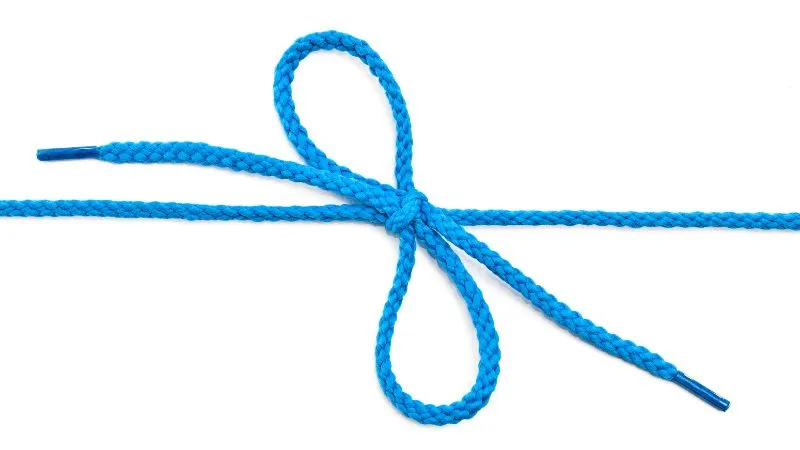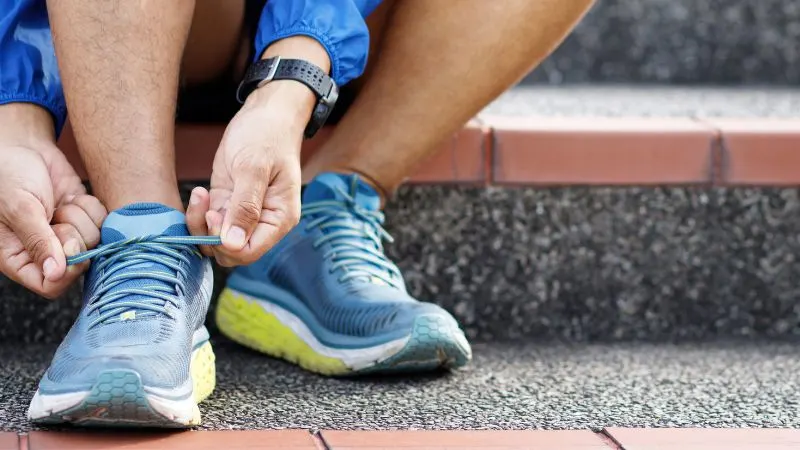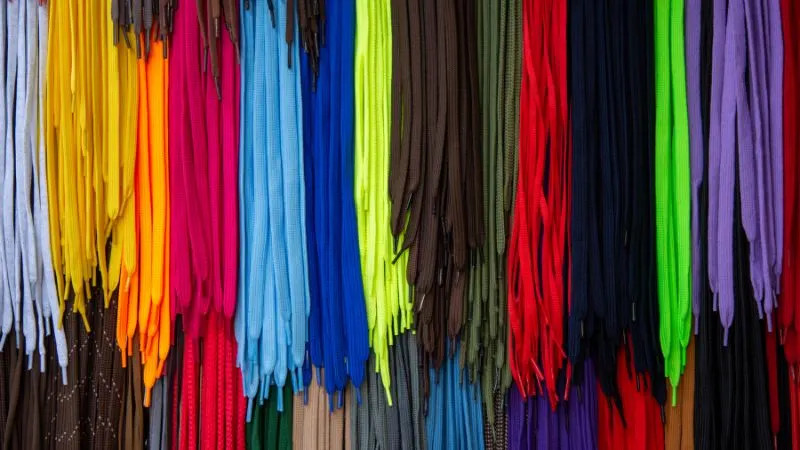
Understanding DIY Shoelaces
Creating your own shoelaces can be a fun and rewarding project. You’ll learn to work with different materials, and design laces that are unique to your style.
The Basics of DIY Shoelaces
Materials You’ll Need:
- Fabric or rope
- Measuring tape
- Scissors
- Lace tips or shrink tubing
- Sewing machine (optional)
To make fabric shoelaces, you start by measuring the length you need for your shoes. Use a measuring tape to get this length and add a few inches for knotting or sealing the ends. Cut the fabric into strips about 1 inch wide, which will fold down to a 3/8 inch lace.
Step-by-Step Process:
- Cut your chosen material to the desired length.
- Fold the material in half lengthwise, and then fold the edges into the middle.
- Stitch along the length to secure the folds.
- Seal the ends with lace tips or shrink tubing to prevent fraying.
Remember to use a thread color that matches or complements your lace material. This way, your DIY shoelaces will look neat and finished.
Different Types of Shoelaces
Materials and Their Benefits:
- Fabric: Customizable and soft, fabric laces can match or accent your shoes.
- Rope: Rugged and durable, rope laces are great for boots or outdoor shoes.
- Heat shrink tubing: This is used to seal the ends of your shoelaces for a clean finish.
You have a lot of choices when it comes to designing your DIY shoelaces. The material you choose affects both how the shoelaces look and how they function. If you like a classic look, fabric might be the way to go. For a more durable pair, especially for boots, using rope can add an extra touch of sturdiness. If you’re using rope, make sure the ends are sealed well with shrink tubing or tips, as rope can fray easily without proper finishing.
Materials and Tools Required
Making your own shoelaces is a fun and creative way to add a personal touch to your footwear. You’ll need a few materials and tools to get started, such as fabric, sewing essentials, and aglets to cap off the ends.
Choosing the Right Fabric
When selecting fabric for your shoelaces, you have various options. Cotton, nylon, and polyester are commonly used because they’re strong and durable. For a unique look, you can even use upcycled materials like old T-shirts.
- Cotton: Soft and natural, ideal for everyday sneakers.
- Nylon: Great for a more rugged lace, suitable for outdoor shoes.
- Polyester: Durable and resistant to abrasion, good for athletic footwear.
Sewing Essentials
You’ll need the following tools to cut and sew your shoelaces:
- Scissors or Rotary Cutter: For making precise cuts on your fabric.
- Measuring Tape or Ruler: To measure the length of your shoelaces.
- Sewing Machine or Fabric Glue: To hold the fabric together securely.
- Bias Tape Maker (optional): To easily fold your fabric edges before sewing.
Ensure to use thread that matches or complements your fabric color for a seamless look.
The Role of Aglets in Shoelaces
Aglets are the small tips at the end of the laces that prevent fraying and make lacing easier. They can be made of plastic or metal.
- Plastic Aglets: These are usually heat-shrink tubing that tightens around the ends of the laces.
- Metal Aglets: To attach these, you may need small tools like pliers, but they offer a lasting finish and stylish look.
Creating Your Shoelaces

Making your own shoelaces is a fun and creative sewing project. With a few simple materials and some sewing skills, you can customize your footwear with diy fabric shoelaces that truly reflect your style.
Cutting and Preparing the Fabric
To start your diy shoelaces, select a fabric that suits your taste and the shoes you want to lace up. Cotton or nylon works well because they are durable and easy to work with. You’ll need:
- Fabric: A strip about 45 inches long and 1 inch wide for standard size laces.
- Ruler: To measure your fabric strip.
- Scissors: For cutting the fabric neatly.
Cut your fabric strip to the desired length, remembering that it’s better to have laces a bit too long than too short. You can always trim them later. Fold the strip in half lengthwise and iron it to create a crease; this will be your sewing guideline.
Sewing the Shoelaces
Once you’ve prepared your fabric strip, it’s time to sew. If you’re hand-sewing, use a simple backstitch for strength. For those using a sewing machine, a straight stitch will suffice.
- Start along the crease of your fabric, sewing the edges together.
- When you reach the end, make a small knot or backstitch to prevent unravelling.
- Trim any excess thread.
Remember, the goal here is to create a long tube. Once sewn, use a safety pin or a small knitting needle to turn the fabric tube right side out.
Attaching the Aglets
Aglets are the plastic or metal tips at the end of shoelaces that prevent fraying. Here’s how to attach them to your DIY fabric shoelaces:
- Shoelace Aglets or Clear Heat Shrink Tubing: Choose the one you like most for the ends of your laces.
- Glue: For securing the aglets to the fabric.
If you’re using heat shrink tubing, cut a small piece to fit the ends of your laces. Slide it over the end and apply heat with a hairdryer until it tightly wraps around the lace. If you have shoelace aglets, apply a small amount of glue to the inside of the aglet and press onto the ends of the laces until secure.
And there you have it, a simple approach to making your own stylish and personalized shoelaces!
Customization Techniques
Customizing your shoelaces is a fun way to express your unique style. Here, you’ll discover how to add patterns and prints to your laces, as well as how to use washi tape for that extra flair.
Designing Patterns and Prints
Patterns: Adding patterns to your shoelaces can be as simple or complex as you like. One way to achieve this is by using fabric paints. Just lay your laces flat and paint your design directly onto them. If you’re looking for precision, use stencils to create repeating patterns.
- Stripes: Alternate colors for a striped pattern using painter’s tape to keep lines neat.
- Polka dots: Use the end of a paintbrush to add perfect dots.
- Checks: Create a checkerboard effect by painting squares in alternating colors.
Prints: If you’re interested in prints, you can use stamps dipped in fabric paint to transfer your favorite shapes and icons onto the laces. Make sure to let your laces dry completely before threading them through your shoes.
Tips:
- Use light-colored laces for better visibility of your patterns.
- Apply a clear sealant to preserve the design after the paint dries.
Decorating with Washi Tape
Washi Tape: This decorative tape can transform your laces quickly and with no mess. Select tapes with colors and patterns that speak to you.
- Step 1: Measure the length of washi tape against your shoelace and cut it slightly longer to wrap around.
- Step 2: Carefully place the tape along one side of the lace, and then fold it over onto the other side, smoothing out any bubbles.
- Step 3: Trim any excess tape from the edges for a clean finish.
Mix and Match: Feel free to combine different washi tape designs along the length of the lace for a unique look. Because washi tape isn’t permanent, you can change up the designs as often as you like!
Note:
- Opt for high-quality washi tape to ensure better adhesion to the fabric of the laces.
Care and Maintenance

Taking good care of your DIY shoelaces will keep them looking fresh and last longer. Here’s how you can clean and store them properly.
Cleaning Handmade Shoelaces
Fabric shoelaces you’ve made by hand need to be cleaned with care to preserve their color and integrity. Here’s an easy way to do this:
- Remove the laces from your shoes to prevent any water from getting into your shoes.
- Prepare a cleaning solution by mixing a little bit of mild soap with warm water.
- Soak the laces in the solution for about 15-30 minutes.
- Gently rub them together in your hands or use a soft brush to work out any dirt.
- Rinse them well with cold water to remove any soap residue.
- Dry the laces by laying them flat on a clean towel and let them air dry completely before putting them back in your shoes.
For tough stains, you might need to treat the area with a stain remover before following the above steps. Remember, never put fabric laces in the dryer as it could shrink or damage the material.
Storing Fabric Shoelaces
After cleaning your fabric shoelaces, ensure they are completely dry before storing them to avoid mold and mildew. Here’s the best way to store them:
- Roll the laces: Gently roll your clean, dry laces into a coil to prevent them from getting tangled.
- Choose the right container: Use a small container or a zip-lock bag to keep the laces dust-free.
- Keep them separated: If you have multiple pairs, store them separately or label them so you can easily find the pair you need.
By following these storage tips, your laces will be organized, easy to find, and ready to use whenever you need them.
Frequently Asked Questions
How can I make no-sew shoelaces at home?
You can make no-sew shoelaces using durable materials like paracord or leather strips. Simply cut the material to the desired length, then secure the ends. You can use clear nail polish or glue to prevent fraying.
What materials do I need to create custom shoe laces?
To create custom shoelaces, you’ll need a material like fabric strips, paracord, or leather, as well as scissors for cutting. Depending on the material, you might also need tools to seal the ends, like glue or heat shrink tubing.
What are some creative ways to style shoelaces?
You can braid different colors of yarn or string together, use beads, or even add small charms to your laces for a unique look. Try experimenting with different lacing techniques for a fresh style.
How do you fashion shoelaces out of yarn?
To make shoelaces from yarn, braid together several strands until you reach the needed thickness and length. Finish by sealing the ends with glue and allowing them to dry.
Can you use ribbon to make your own shoelaces?
Yes, ribbon can be an excellent material for shoelaces. Choose a ribbon that is durable and not too wide, then cut to length. Seal the ends to prevent fraying, using clear nail polish or glue.
What alternatives exist for traditional shoe laces?
Besides custom-made laces, alternatives include elastic no-tie laces, locking mechanisms, or even different lacing methods that change the fit and look of your shoes.
